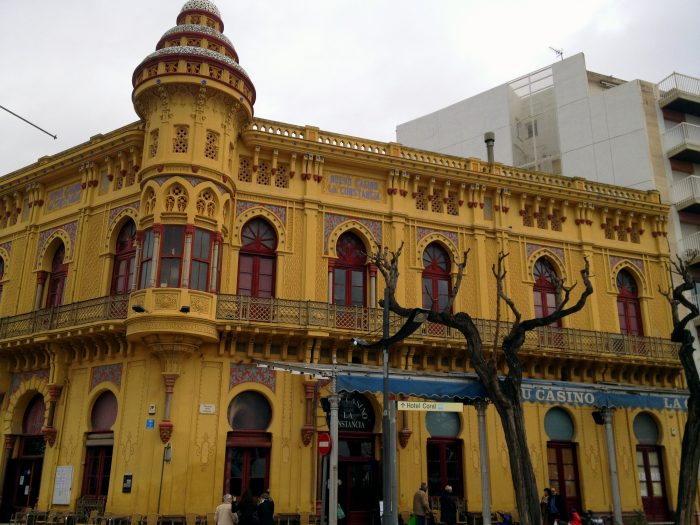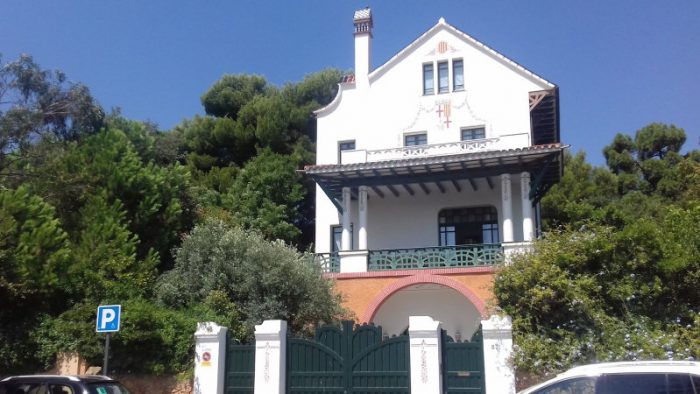How Catalan modernism transformed architecture in Barcelona and beyond with nature-inspired designs.

Sagrada Familia is Gaudí’s still unfinished masterwork. Photo by Patrice Audet
Catalan modernism, known as modernisme, was a cultural and artistic movement that emerged in Catalonia, particularly in Barcelona, during the late 19th and early 20th centuries. This movement was more than just a change in architectural style – it symbolised the region’s growing sense of identity and independence, reflecting the social, political, and economic shifts of the time. While modernisme is often linked to architecture, it also played a crucial role in literature, the visual arts, and craftsmanship.
Origins of Catalan modernism
The birth of modernisme was deeply connected to the social and political landscape of Catalonia at the turn of the 20th century. The movement grew out of a period of great change, driven by industrialisation and a renewed interest in Catalan culture and identity.
The historical backdrop of modernism
By the late 19th century, Catalonia was becoming one of Spain’s most industrialised regions, with Barcelona emerging as a major industrial centre. This period of growth and prosperity was accompanied by the rise of a wealthy bourgeois class, which sought to express its status through cultural and artistic means. At the same time, the Renaixença was gaining momentum, a cultural movement aimed at reviving the Catalan language and reinforcing regional pride.
Modernisme developed within this context, reflecting a blend of local identity and European artistic trends. Catalan artists and architects were inspired by movements such as Art Nouveau and Symbolism but sought to give these styles a distinct local flavour. Their work became a vehicle not only for aesthetic innovation but also for expressing Catalonia’s unique cultural aspirations during a time when regional autonomy was increasingly sought.
Industrialisation and urbanisation
Alongside the cultural revival of the Renaixença, the industrial revolution was transforming the physical and economic landscape of Catalonia. Factories, particularly in textiles, drove rapid urban growth, especially in Barcelona. The city’s population surged, and with it came a new wave of wealth and social mobility. The Catalan bourgeoisie, in particular, sought to display their new status through grand, innovative architecture, commissioning many of the famous modernisme projects.
This expansion was guided by the ambitious urban plan of the Eixample district, designed by Ildefons Cerdà in 1859. The grid-based design of Eixample allowed for broad, tree-lined streets and spacious blocks, offering architects the perfect opportunity to create buildings that would define Barcelona’s skyline for generations to come. It was within this planned framework that Catalan modernist architects found a blank canvas to experiment with bold, artistic forms that symbolised both progress and regional pride.
Characteristics of Catalan modernism
Catalan modernism was defined by a distinct aesthetic that set it apart from other contemporary movements. While it shared certain similarities with European styles such as Art Nouveau, modernisme had its own unique identity, shaped by local traditions, nature, and Catalan craftsmanship. These characteristics were most prominent in architecture but also extended to decorative arts and literature.
Organic forms and intricate details
A hallmark of modernisme was its departure from rigid, classical forms. Architects embraced a more fluid, natural approach, drawing inspiration from the organic world. This was reflected in the sinuous, undulating lines of buildings, the use of curved facades, and the detailed ornamentation that mirrored the shapes of plants, flowers, and animals.

Gaudí’s designs for Parc Güell were influenced by nature. Photo by Adora Goodenough
At the same time, this movement was highly detailed in its execution. Buildings were often adorned with elaborate patterns, mosaics, and sculptures, creating rich, textured surfaces. Architects and artisans worked together to craft iron railings, ceramic tiles, and stained glass that would bring life to the exteriors and interiors of structures. This craftsmanship was a point of pride, linking the movement to the region’s artisanal heritage while also showcasing its innovation.
Innovation with materials and technology
Although modernisme took inspiration from natural forms, it was also forward-thinking in its use of materials and construction techniques. Architects experimented with new industrial materials like steel, iron, and concrete, which allowed them to explore previously unimaginable designs. The combination of traditional craftsmanship with these modern materials became a defining feature of Catalan modernist architecture.
For example, iron was used extensively, not just for structural purposes but also as a decorative element in balconies, gates, and window grilles. Stained glass was also a key material, employed to add colour and light to buildings, often featuring intricate designs that depicted scenes from nature or local folklore. The integration of these new techniques, while still maintaining a strong connection to craftsmanship, allowed modernisme to blend the old and the new in a way that was both innovative and deeply rooted in Catalan culture.
Antoni Gaudí and the giants of Catalan modernism
Although modernisme is often associated with the genius of Antoni Gaudí, many other talented architects, artists, and designers played significant roles in shaping the movement. While Gaudí’s creations are among the most famous, the collective contributions of several key figures were instrumental in defining and advancing Catalan modernism.
Antoni Gaudí: An architectural visionary
Antoni Gaudí is the best-known exponent of Catalan modernism, renowned for his ability to blend architectural innovation with his love of nature and religious symbolism. His works, such as La Sagrada Família, Casa Batlló, and Park Güell, are celebrated for their flowing forms, colourful mosaics, and the incorporation of natural elements.

Detail of Antoni Gaudí’s Casa Batllo in Barcelona. Photo by José Jóvena
Gaudí’s designs are marked by their curvilinear forms, often avoiding straight lines entirely, as he believed that they did not exist in the natural world. His buildings seem to grow organically, with facades that resemble living organisms and interiors that feel like caves or forests. His use of trencadís—mosaics made from broken ceramic tiles—became one of the signature elements of his work, allowing him to create vibrant, textured surfaces that shifted and shimmered with light.
Lluís Domènech i Montaner and Josep Puig i Cadafalch
While Gaudí’s name may dominate discussions of modernisme, Lluís Domènech i Montaner and Josep Puig i Cadafalch were also pivotal figures in the movement. Each brought his own vision and innovations, contributing to the richness and diversity of Catalan modernist architecture.
Domènech i Montaner, known for his deep understanding of historical architecture, created some of the most emblematic buildings of the movement, including the Palau de la Música Catalana and the Hospital de Sant Pau. His approach often blended modern techniques with traditional elements, creating structures that were both functional and symbolic of Catalonia’s cultural aspirations.
Puig i Cadafalch, another leading modernist architect, also left his mark with works such as Casa Amatller and Casa de les Punxes. His designs often incorporated Gothic elements and Catalan medieval influences, showing how modernisme could embrace both innovation and tradition. Like his contemporaries, Puig i Cadafalch was also deeply engaged in promoting Catalonia’s political and cultural independence, and his work often reflected this sense of regional pride.
Catalan modernism and the transformation of Barcelona
Barcelona is often seen as the heart of modernisme, a city where the movement not only flourished but also permanently altered its urban landscape. This transformation was driven by the work of architects, artists, and urban planners who envisioned a new, forward-thinking Barcelona that balanced innovation with Catalonia’s cultural identity.
The role of the Eixample district in modernist architecture
One of the most significant developments in Barcelona during the late 19th century was the creation of the Eixample district, designed by Ildefons Cerdà. This district, characterised by its grid pattern and wide avenues, provided the perfect backdrop for the rise of modernisme. The new urban space allowed architects to experiment with large, decorative facades and intricate interiors, showcasing the ideals of the movement.

Barcelona’s Eixample district. Photo by Jorge Salvador
The Eixample became a canvas for some of the most iconic modernist buildings, with structures like Casa Batlló and Casa Milà (La Pedrera) standing as enduring examples of how modernisme reshaped Barcelona’s skyline. The wide streets and open squares of Cerdà’s design also encouraged a blend of public and private space, allowing the beauty of modernist architecture to be enjoyed by all, not just those wealthy enough to commission it.
How modernisme defined Barcelona’s identity
As modernisme spread across the city, it became a defining feature of Barcelona’s identity. Buildings adorned with vibrant mosaics, wrought iron balconies, and fantastical forms helped transform the city into a living museum of architectural and artistic innovation. These structures not only housed the wealthy and powerful but also reflected the growing aspirations of the city as a hub of culture, progress, and Catalan pride.
Over time, modernisme became synonymous with Barcelona itself. The architectural style, deeply connected to the spirit of the city, attracted visitors from around the world, eager to experience the distinct blend of tradition and modernity that characterised this unique movement.
Girona: a hidden gem of modernist architecture
Girona, with its medieval charm and historical significance, might not immediately come to mind as a centre for modernisme. However, the city features several notable modernist structures that stand in contrast to its ancient streets and Romanesque architecture. One of the most prominent examples is the building for Teixidor flour, designed by Rafael Masó, one of the leading modernist architects in Girona. This industrial building stands out for its striking design, blending modernist elements with functional architecture. Masó’s use of ceramics, decorative brickwork, and elegant ironwork turned a practical structure into an artistic statement, embodying the ideals of modernisme.
Masó’s approach to architecture also marked a transitional phase towards noucentisme, a movement that emerged in response to modernisme. Unlike the more flamboyant, organic forms of modernisme, noucentisme emphasised order, classicism, and a return to Mediterranean traditions. Masó’s work, especially in Girona, reflects this shift. His clean lines, balanced compositions, and subtle use of decorative elements in buildings like Casa Masó anticipated the restraint and simplicity that would come to define noucentisme.
By bridging the two movements, Masó played a critical role in shaping both the late phase of modernisme and the early development of noucentisme, influencing a generation of architects who would follow his lead in championing Catalonia’s cultural identity through a more restrained aesthetic.
The Costa Brava: Catalan modernism in coastal towns
The Costa Brava, known for its rugged coastline and picturesque villages, also boasts several examples of modernisme, especially in towns like Cadaqués, Lloret de Mar, and Sant Feliu de Guíxols. These coastal areas, popular holiday destinations during the late 19th and early 20th centuries, became ideal locations for wealthy Catalans to commission modernist summer residences and public buildings.
In Lloret de Mar, modernisme is visible in buildings like the cemetery, where several tombs and mausoleums were designed by modernist architects such as Puig i Cadafalch. These structures, characterised by intricate stonework and sculptural details, bring the elegance and artistic innovation of modernisme to a unique setting. The cemetery is a striking example of how the movement’s ideals could be adapted to different types of spaces, even those with a sombre purpose.

The distinctive architecture of Casino de Constància. Photo by David Leigh
Sant Feliu de Guíxols, another coastal town on the Costa Brava, is home to the Casino La Constància, an iconic modernist building designed by Albert Juan i Torner. The casino’s elegant facade, with its detailed ornamentation and use of ceramic tiles, reflects the influence of modernisme even in leisure spaces, where the movement’s characteristic attention to detail and artistic flair were applied to create a sophisticated and inviting atmosphere.

Casa Girbau Estrada in Sant Pol dates from 1910 and marks the transition from Catalan modernism to noucentisme. Photo by David Leigh
Each of these examples demonstrates how modernisme found its way to the Costa Brava, adapting to the local environment while maintaining the movement’s core principles of beauty, craftsmanship, and innovation.


